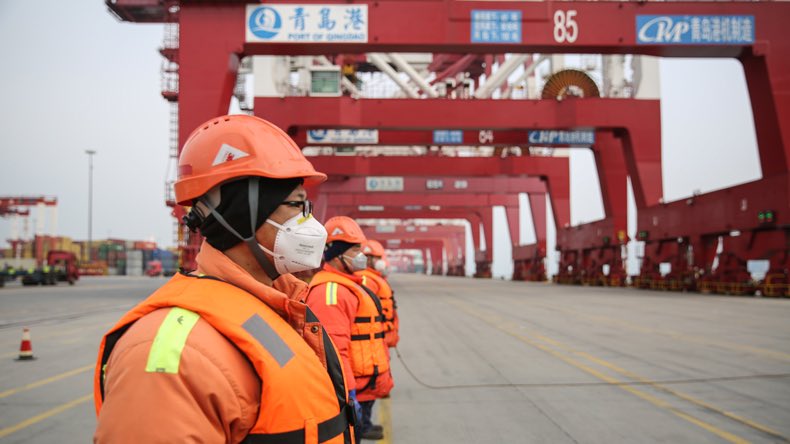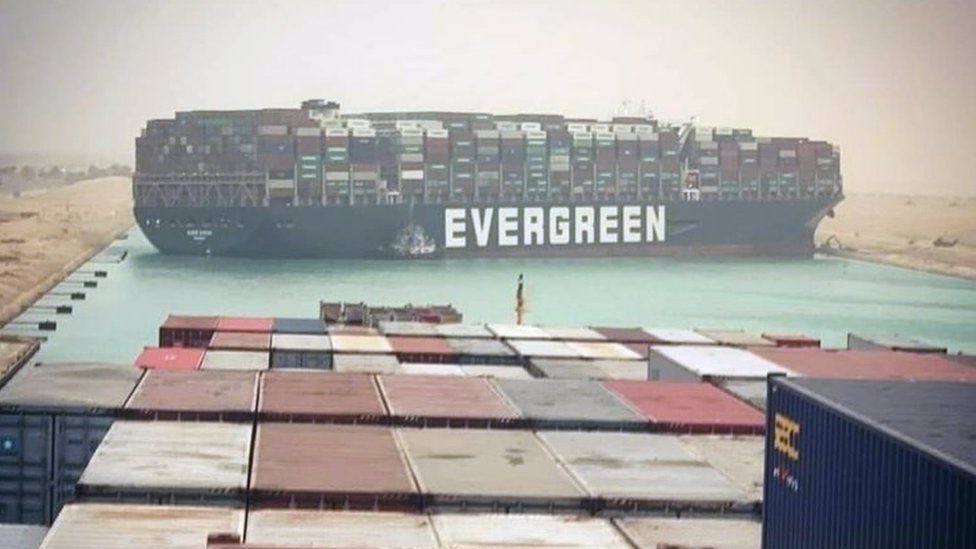By now, you’ve probably heard that global supply chains are in a state of disarray.
Here's a simple breakdown of what’s causing it:
Here's a simple breakdown of what’s causing it:

1/ There's a lot of talk right now about the global supply chain crisis.
@business published an article subtitled "Inside the Brutal Realities of Supply Chain Hell”—it's getting serious.
This thread provides my (very) simple framework for understanding the key drivers:
@business published an article subtitled "Inside the Brutal Realities of Supply Chain Hell”—it's getting serious.
This thread provides my (very) simple framework for understanding the key drivers:
2/ First off, what are the visible impacts of the crisis?
Product delays (good luck getting appliances before 2022), product shortages (see semiconductors), port buildups (fly over LA and you'll see), and rampant freight costs (sorry, retailer margins).
It's pretty bad.
Product delays (good luck getting appliances before 2022), product shortages (see semiconductors), port buildups (fly over LA and you'll see), and rampant freight costs (sorry, retailer margins).
It's pretty bad.

3/ Global supply chains are very complex. We live in a highly-interconnected world.
A butterfly flaps its wings in Shenzhen and impacts when I receive my bike in New York. Ok, maybe not quite, but almost...
So to understand the drivers of the crisis, we need a simple framework.
A butterfly flaps its wings in Shenzhen and impacts when I receive my bike in New York. Ok, maybe not quite, but almost...
So to understand the drivers of the crisis, we need a simple framework.
4/ Let's break down what is happening using an Econ 101 classic: Supply and Demand.
Supply here refers to everything related to manufacturing, production, and transportation.
Demand here refers to everything related to consumption.
I'll walk through each side:
Supply here refers to everything related to manufacturing, production, and transportation.
Demand here refers to everything related to consumption.
I'll walk through each side:
5/ First, demand. This one is pretty simple: it's through the roof.
Consumers are flush and not afraid to spend.
Further, lockdowns and restrictions have meant more spending on goods vs. services.
So you have a ton of demand for goods--those goods need to come from somewhere!
Consumers are flush and not afraid to spend.
Further, lockdowns and restrictions have meant more spending on goods vs. services.
So you have a ton of demand for goods--those goods need to come from somewhere!
6/ Next, supply. This one is more nuanced.
The major supply drivers I see here:
(1) Factory shutdowns
(2) Port shutdowns
(3) Flight reductions
(4) Container ship challenges
Hitting each one quickly:
The major supply drivers I see here:
(1) Factory shutdowns
(2) Port shutdowns
(3) Flight reductions
(4) Container ship challenges
Hitting each one quickly:
7/ COVID Factory Shutdowns
Factories—particularly in Asia—have had a tough time managing and containing outbreaks of COVID.
This leads to delays and bottlenecks in production. If an upstream manufacturer is delayed, that impact cascades downstream and has an extensive impact.
Factories—particularly in Asia—have had a tough time managing and containing outbreaks of COVID.
This leads to delays and bottlenecks in production. If an upstream manufacturer is delayed, that impact cascades downstream and has an extensive impact.
8/ COVID Port Shutdowns
Ports have experienced similar challenges—any have had to shut down or restrict labor to avoid outbreaks.
If ports are closed, products can't flow smoothly through the supply chain.
It's like creating a kink in a hose and watching pressure build.
Ports have experienced similar challenges—any have had to shut down or restrict labor to avoid outbreaks.
If ports are closed, products can't flow smoothly through the supply chain.
It's like creating a kink in a hose and watching pressure build.

9/ Flight Reductions
It's news to most people, but about 50% of air cargo flies on passenger flights.
It's a great revenue stream for passenger airlines.
But with travel—especially international travel—reduced by COVID, there was a significant reduction in air cargo capacity.
It's news to most people, but about 50% of air cargo flies on passenger flights.
It's a great revenue stream for passenger airlines.
But with travel—especially international travel—reduced by COVID, there was a significant reduction in air cargo capacity.

10/ Container Ship Challenges
The Ever Given clogged the Suez Canal in March, causing a backlog whose impact cascaded through global supply chains.
There aren't enough large container ships to meet all of this demand and containers are in the wrong places at the wrong times.
The Ever Given clogged the Suez Canal in March, causing a backlog whose impact cascaded through global supply chains.
There aren't enough large container ships to meet all of this demand and containers are in the wrong places at the wrong times.

11/ So looking at all of this through my simplistic framework, here's what I see:
On one end, a structural surge in demand for goods.
On the other end, a number of significant supply challenges and disclocations.
Demand up, supply down.
On one end, a structural surge in demand for goods.
On the other end, a number of significant supply challenges and disclocations.
Demand up, supply down.
12/ The net impact: sharp shipping and production price increases, shortages, and massive delays.
For consumers, this means rising prices, as these rising supply chain costs are passed through.
Your holiday shopping may be a whole lot more expensive (and late) this year...
For consumers, this means rising prices, as these rising supply chain costs are passed through.
Your holiday shopping may be a whole lot more expensive (and late) this year...

13/ I hope this simple breakdown helps you feel more well-informed about what is happening with the global supply chain crisis.
Follow me @SahilBloom for more threads on business and finance.
I also write about these topics in my newsletter. Subscribe! sahilbloom.substack.com
Follow me @SahilBloom for more threads on business and finance.
I also write about these topics in my newsletter. Subscribe! sahilbloom.substack.com
For more on the supply chain crisis, I recommend following @EytanBuchman @man_integrated @typesfast—all are way more in the weeds and well-informed on these topics.
Also, these articles are great:
wsj.com/articles/germa…
wsj.com/articles/cargo…
Also, these articles are great:
wsj.com/articles/germa…
wsj.com/articles/cargo…
By the way, if you’re looking for Christmas presents that you can get at a reasonable price, I hear Evergrande has some really nice half-finished apartments on offer at a deep discount… 

Looks like a lot of people are flocking to Evergrande offices to take advantage of this limited time opportunity! 

There are a few other supply-side factors that folks correctly mentioned that I will plan to cover in my newsletter piece tomorrow.
• Labor Shortages
• Infrastructure Deficiencies
• China’s Energy Crisis
Join 35K+ others and subscribe today so you don’t miss it.
• Labor Shortages
• Infrastructure Deficiencies
• China’s Energy Crisis
Join 35K+ others and subscribe today so you don’t miss it.
Newsletter deep-dive is live in your inboxes and ears. Read, listen, enjoy, and share!
https://twitter.com/sahilbloom/status/1443189136240877571
• • •
Missing some Tweet in this thread? You can try to
force a refresh






















